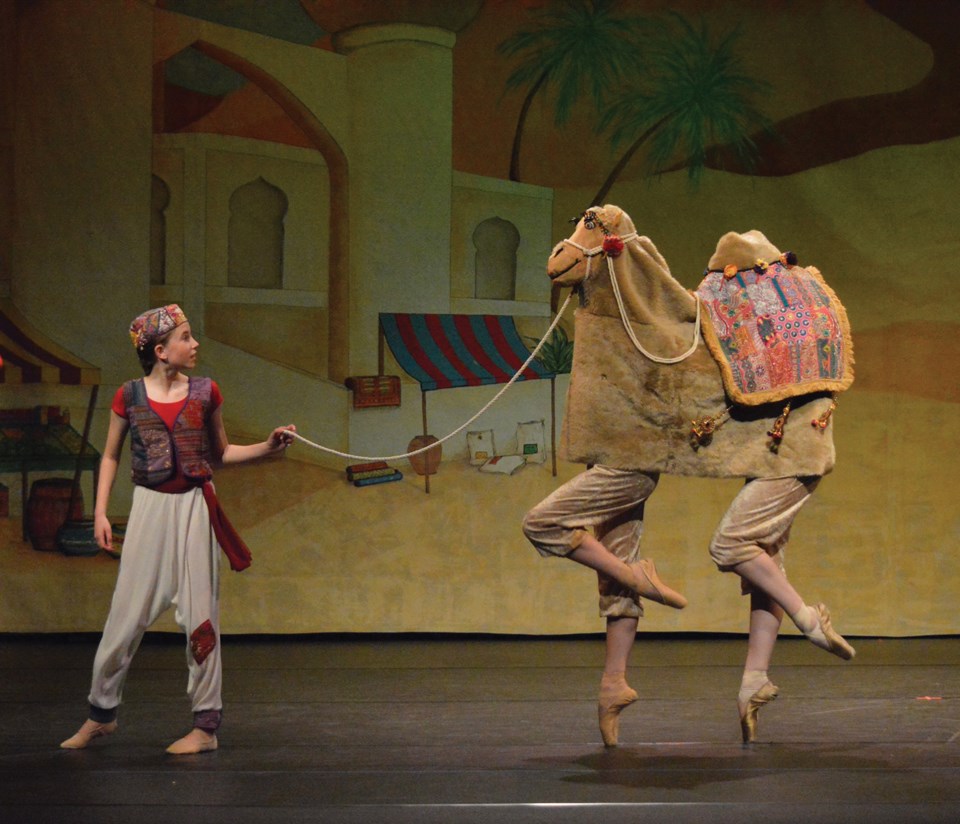A three-year-old wish made by Sechelt’s Waldorf Ballet studio finally came true last weekend, as the dance company delivered captivating performances of its long-awaited Aladdin production.
The 90-minute ballet was originally scheduled for early 2020. COVID-19 health orders shut down rehearsals during spring break that year.
“It kind of got shelved for a bit there,” said Johanna Waldorf, artistic director of Waldorf Ballet. “And the years after that were still a bit complicated. So it’s really fun to bring it back to life after being on hold like that.”
Every dancer in the hundred-member youth company assumed a role over four lavishly-costumed performances. The musical score, by American composer Carl Davis, was originally commissioned for the Scottish Ballet at the turn of the century.
The staging pushed the limits of the Raven’s Cry Theatre. As the overture played, a single dancer bounded across the platform, igniting imaginations. The main drape opened to reveal a bustling bazaar, set against a full-height painted desert landscape.
Even before Aladdin (played by the ever-smiling Audrey Altenburg) could charm spectators with her graceful agility, the character’s monkey companion (portrayed alternately by Charlotte Altenburg and Sophie Trinh) elicited chuckles with its antics. The fez-wearing creature rubbed its belly and pouted to emphasize its straitened circumstances.
The crowded marketplace scene was populated by advanced program dancers in the guise of royal handmaidens. Combined with basket vendors played by Anastasia Shvartsman, Eliana Rintoul and Ophelia Gray, the result was a riot of colourful scarves and silks amid a blur of open-air commerce conducted en pointe.
Morgan Richmond brought stately elegance to the role of the conniving Sorceress, with her indentured parrot (Miyo Shinagawa) in tow. Richmond conveyed menace through solemn subtlety, her movements calculated to woo Aladdin on an underground quest.
Isabella Watts, who danced the role of Jasmine — a princess with an appetite for the hurly-burly of commoner life — displayed regal poise as counterpoint to the waggish skylarking of Altenburg’s Aladdin.
The depiction of snake charming by a trio of undulating serpents, wrangled by hypnotist Lauren-Grace Robinson, united woodwind riffs, acrobatic choreography, and gleaming bodysuits in a theatrical tour de force.
The second act transported Altenburg and Watts, accompanied by the waggish monkey, to a mist-filled cave of wonders. Aladdin’s discovery of a magic lamp summoned the Genie, danced by Brooklyn Turner in a dazzling display of high-velocity pirouettes and long-distance leaps.
“Aladdin’s first wish,” said Waldorf, “is to become rich. That’s where we introduced all these different riches and jewels, which are a lot of our younger students in the school.”
The dancers who portrayed precious stones added metaphorical veneer to the ancient tale, hinting that the value of ephemeral art is greater than inert minerals. A corps of anthropomorphic pearls wore diaphanous dresses, illuminated electrically from within, which lit impromptu waves by the young performers to family members beyond the footlights.
Altenburg and Watts’ escape from the cavern aboard a genie-propelled magic carpet preceded a summary deposition of the evil sorceress. Love triumphed; Aladdin’s state was elevated; the genie was liberated in an act of joyful generosity.
With its year-end production complete, Waldorf Ballet plans to launch summer training for girls and boys aged three and up before regular classes resume in September.





